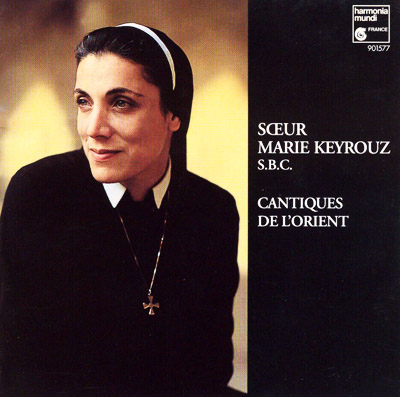 Canticles of the East
Canticles of the East
| 25,00 ą |
-
Magnificat
03:50
Sister Marie Keyrouz – Magnificat
-
Ilahi hanayta
3:45
Sister Marie Keyrouz– Ilahi hanayta
-
Ya sakban
03:57
Sister Marie Keyrouz – Ya sakban
-
Amamaka
02:54
Sister Marie Keyrouz – Amamaka
-
Arrabou
04:01
Sister Marie Keyrouz – Arrabou
-
Kama yachtaqu
02:33
Sister Marie Keyrouz – Kama yachtaqu
-
Ousaylu anka
03:54
Sister Marie Keyrouz – Ousaylu anka
These canticles of the east have a twofold aim in mind: on the one hand, to go back to the very earliest tradition in which poetry and music were at the service of the cult and of the faith, and, on the other hand, to reach a much larger audience, whe
ther it be comprised of believers, practising Christians, atheists or agnostics.
Although their composition is modern, the music of these canticles is based on the earliest forms of the Eastern musical scales, eight modes whose compass came to embrace up to two and a half octaves this applies to both of written music and the improvisations.
The musical composition, the choice of the modes, and the way they are used are closely linked to the meaning of the sacred text.
Improvisation plays an important part in this recording : it aims at expressing the inexpressible. Born of a confession of faith, the music must serve the text, manifest the personal faith of the singer.
It should incarnate the theological and emotional contents of the words as well as the singer's vocal skills, and is particularly appropriate for sung lessons.
On the compositional level it seems to us imperative to recall the requirements that remain in force if the message of the chant is to attain its goal.
For, to our mind, the music, ranging from the simplest and most easily remembered responsorial form to the most melismatic and elaborate style , must help to render the notion of the sacred palpabl.
The texts of the chants on this record were written and are sung in Arabic, a more widelyspoken and understood language than Greek or Syriac.
At times, therefore, the verse is of a more popular nature ; the rhytm then becomes lighter, the music easier to remember and the enthusiasm and dynamic impulse more communicative.
On the other hand, whenever the words are bearers of a theological or dogmatic precept, as in the phrase, Be Thou mindful of us before Christ our God , the music once more becomes improvisatory.
In a word, the voice, the text, the instrument and the music must become one in the service of the Sacred, so that the message is transmitted, leading the listener, the 'other', to a complative state of mind and soul and to prayer.
Whether it be a catechic, a musical or a devotional implement, this recording aims at being an encounter and a prayer. But is this not the aim of all sacred song ?
Sister Marie Keyrouz
- ←
- 1
- →